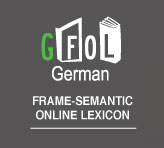Frame description
In this frame, some Cause causes an Effect. Almost any kind of thing could constitute a Cause, such as a person, a thing, or a whole situation. When the Effect happens to a particular entity, we call this entity the Affected.
Examples:
| 1. Die Treibhausgase verursachen die globale Erwärmung. | 1. Greenhouse gasses cause global warming. |
| 2. Martha zerbrach den Teller, weil ihr Freund mit ihr Schluss machte. | 2. Martha broke the plate, because her boyfriend broke up with her.3 |
| 3. Das Gemälde macht das Zimmer hell und warm. | 3. The painting makes the room light and warm. |
It is important to know that many of the words in this frame, e.g. "der Grund" ("reason") and "warum" ("why"), can also evoke a situation in which someone intentionally responds to a state of affairs by performing an action. Although this is not always genuine causation (because people have the freedom of choice), it is expressed linguistically in the same way (see example 2). Both English and German allow their speakers to construe intentional responses as Effects of an outside Cause, which makes a volitional action seem involuntary. (This is one way human language and thought might influence one another. For more information, look into the theory of linguistic relativity.)
